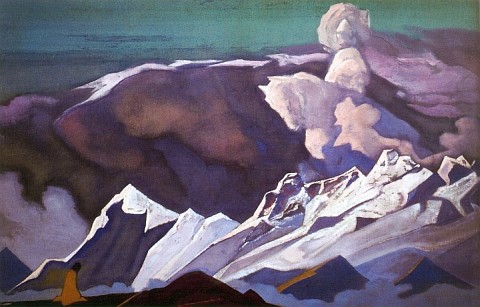|
|
A RUSSIAN MODERN MYSTIC - NICHOLAS ROERICH
11/12/2010 11:09:10 AM
|
Dear Friends, I guess the time is ripe for featuring Nicholas Roerich (1874-1947), one of the most prolific and enlightened artists the world has ever seen. An outstanding character indeed, and one who very appropriately can be compared to the great Leonardo, not only was he a great painter, a stage designer and an inspired author, but he also was an archaeologist, a philosopher, a famous lecturer and a great traveler who became a politician and a diplomat in the same spell, a typographer, the founder of a family of illuminated artists and, most importantly, one of the most influential religious thinkers of his time. Finding about the life and deeds of this great creator of beauty and of so many other important things has been one of the most fascinating experiences in my life. However, nothing prepared me for the amazing fact that all of it has come to me at a stage in my life when I am deeply engrossed with the New Age phenomenon, of which he probably was the earliest precursor. An indication of this can be the fact that he frequently painted inspired representations of the Buddha Maitreya and of Kalki Avatar, who according to Buddhists and Hindus alike are supposed to be the inaugurators of the coming Golden Age after the current evil state of things has ended on this Earth. The creator of more than 7,000 works of art, Nicholas Roerich is most difficult to feature in a single thread. However, I have finally decided to have him represented by a work of rare beauty and great mystical depth: his Kalki Avatar, painted in 1932 (see below), although I must say that after seeing other works by him, for example his Zoroaster (1931) or his Elias the Prophet (1931), also temperas of outstanding beauty and mystical intent, or his oil painting The Messenger (Tribe Has Risen Against Tribe) (1897), which earned him an extraordinary reputation as an artist in Russia - his country - at age 24, I have doubted whether my choice was the right one. To list other wonderful masterworks by him would be perhaps excessive, considering their number and the great quality of many of them. Let me mention, however, a few ones, mostly temperas on canvas, that I find especially attractive or simply masterly: Guests from Overseas (1901), Mother of Ghengis Khan (1931, this one a small tempera on cardboard and a gem), Mountain of Five Treasures (1933), Star of the Hero (1933), Tsong-Kha-Pa (1923, another little gem, this one a drawing), and White Himalayas (1931). As always, good feedback from you will be most welcome.
Thank you,
Luis Miguel Goitizolo
 Kalki Avatar (1) Kalki Avatar (1)
By Nicholas Roerich born St Petersburg, 9 Oct 1874;
died Nagar, nr Kulu, Himachal Pradesh, India, 13 Dec 1947.
Technical data (2)
Kalki Avatar, 1932
Tempera on canvas, 61.5 x 96.5 cm,
Bharat Kala Bhavan, Varnasi, India
Profile (3) Roerich, Nicholas [Ryorikh, Nikolay (Konstantinovich)] Russian painter, stage designer and founder of cultural institutions. The son of a lawyer of Scandinavian descent, he graduated from the studio of the landscape painter Arkhip Kuindzhi at the Academy of Fine Arts (1897) and from the faculty of law at the University of St Petersburg (1898). He then studied in Paris with the history painter Fernand Cormon (1900).
Original Russian Nikolay Konstantinovich Ryorikh, Ryorikh also spelled Rerikh (b. Oct. 9 [Sept. 27, Old Style], 1874, St. Petersburg, Russia—d. Dec. 13, 1947, Nagar, India), Russian scenic designer for Sergey Pavlovich Diaghilev’s Ballets Russes who is best-known for his monumental historical sets. He was also a popular mystic.
Educated at the St. Petersburg Academy of Fine Arts, he was not only a scenic designer but also an archaeologist and landscape painter. Roerich’s paintings evidence an intense feeling for the epic dimensions and mystery of nature, particularly prehistoric nature. As a scenic designer Roerich worked within the conservative tradition of the picture-frame stage. His outstanding achievements arose out of the opportunity to create scenic evocations of the past, such as the 12th-century Russia of Polovtsian Dances (1909) from Aleksandr Borodin’s Prince Igor or the legendary Scandinavia of Edvard Grieg’s Peer Gynt (1912).
In 1920 he emigrated to the United States, where he fashioned a reputation as a painter, seer, guru, and peacenik, especially among the well-to-do, who provided him funds and even built him museums, one of which still stands in New York City. In 1930 he befriended Henry Wallace, who, after becoming secretary of agriculture in the Franklin D. Roosevelt administration, sent him on a botanical expedition to the Gobi desert to determine whether conditions there had answers for America’s Dust Bowl. Ignoring his mission for the most part, Roerich waded into Asian politics, roaming with a Cossack bodyguard and vainly urging Buddhist masses to revolution. Wallace broke with Roerich over these events but not before an exchange of letters demonstrated both men’s antic views. (In one letter this oracular view of Manchuria was expressed in fanciful code: “The Monkeys are seeking friendship with the Rulers so as to divide the land of the Masters between them. The Wandering One thinks this, and is very suspicious of Monkeys.”) These so-called “guru letters” came into the possession of a Pittsburgh newspaper but, through the efforts of the Roosevelt administration in 1940, were suppressed. The first excerpts were not published until 1948.
(1) This image is a courtesy of Museum Syndicate. (2) Estonian Roerich Society (Paintings Gallery) (3) Encyclopedia Britannica
|